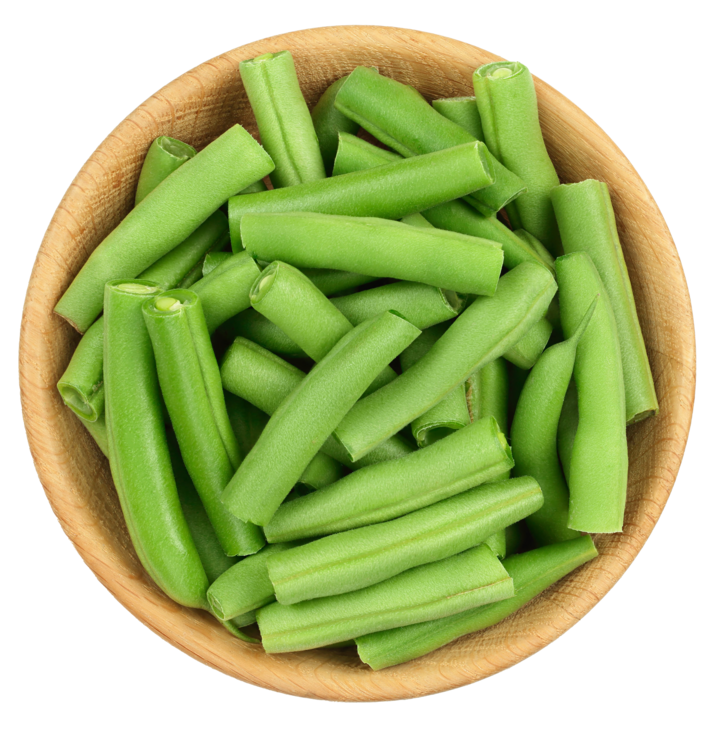Profile
The fisole has many names, it is commonly known as the garden bean(Phaseolus vulgaris L), but is also called the green bean or string bean. Many Austrians grow them in their own gardens.
Depending on the growth habit, the bush bean(Phaseolus vulgaris var. nanus) is distinguished from the pole bean(Phaseolus vulgaris var. vulgaris). Numerous varieties and forms have been cultivated. Their legumes can range from yellow to green to red/purple striped to all blackish purple, and the seeds/beans they contain are even more varied in shape and color.
Usage
In the kitchen, the round, sometimes elongated or kidney-shaped seeds are used, as well as the surrounding pod with the enclosed seeds (green beans, runner beans, princess beans). There are numerous ways to prepare them: cooked with butter or as a side dish, in soups, salads or stews. Before consumption, green beans must be cooked to render the toxic phasin harmless.
Among other things, green beans contain folic acid, vitamin C and magnesium.
Botany

The fisole originates from Central and South America. It is an annual and grows, depending on the form of growth, with an erect to bent, branched stem 20 to 100 cm high (bush bean) or with a branched, usually left-winding stem up to 4 m high (pole bean). The short, upright flower clusters consist of two to twelve, more rarely 20 white, yellowish-greenish, or pink to violet so-called butterfly flowers.
The fisole is a self-fertilizer, especially under long-day conditions. Land day conditions means that the fisoles only bloom when a certain exposure time is exceeded (maximum 12 hours of darkness per day). Nevertheless, there is a small amount of cross-pollination. The plant flowers from the bottom up in 20 to 26 days. The straight or curved legume, 4 to 30 cm long, that develops from the fertilized flowers contains two to nine unicolored or marked seeds of all possible colors.
Agricultural aspects
According to the Federal Ministry of Agriculture, Forestry, Regions and Water Management, around 350 hectares of garden beans are cultivated in Austria (2023). The runner bean grows mainly in warm locations such as southern Styria, Burgenland and the Weinviertel region. Bush beans can also be grown at higher altitudes due to their shorter vegetation period.
Runner beans require a soil temperature of at least 8 to 10 degrees Celsius to germinate. Runner beans are adapted to various climatic and ecological conditions. They thrive best at average temperatures of 18 to 30 degrees Celsius during the growing season, with rainfall distributed as evenly as possible and relatively cool nights below 20 degrees Celsius. As they are very sensitive to frost, they prefer warm, sunny, wind-protected locations. A medium-heavy (sandy-loamy), loose and humus-rich soil produces the best yields. The plants should be supplied with water evenly. There is an increased need for water during the flowering phase. Drying out should be avoided at all costs, otherwise the fruits will be shed prematurely.
Runner beans generally have a longer growing period and therefore take longer to harvest than bush beans. The soil for runner beans should also be deep and loose; heavy soils are less suitable for them. Bush beans thrive on almost all types of soil, but prefer humus-rich, medium-heavy soils with a high proportion of plant-available water. Freshly ploughed meadows and heavily or freshly fertilised areas are unsuitable for cultivation.
Sowing is carried out at a soil depth of 2-4 cm as a single seed with a spacing of 6 to 8 cm in the row or as a clump sowing with five to seven seeds per planting site. The seedlings germinate after approx. two weeks and are relatively undemanding during growth; additional watering is only necessary in very dry conditions and more so for runner beans. As far as fertilisation is concerned, nitrogen-only fertilisation should not be used, as beans are a low-yielding vegetable, but they do require additional potash.
The beans grown in Europe are day-neutral, which means that their flowering is independent of the length of daylight, which is why there are early, medium-early and late varieties. As far as bush beans are concerned, the growth phase lasts 60 to 90 days, depending on the maturity group. With early varieties, the garden beans can be picked after 55 to 60 days, with medium-early varieties after 70 to 75 days. They are harvested when the seeds are about the size of a lentil, the pod breaks through smoothly when bent and is juicy at the breaking point. Dry beans are only harvested when the seeds are fully ripe and dry, which is best recognised by a dry pod. In the case of bush beans, this can be as early as August, while runner beans can usually only be harvested in mid-September.
Last updated: 07.11.2024
automatically translated